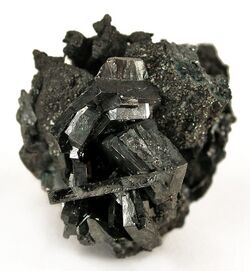Chemistry:Stephanite
| Stephanite | |
|---|---|
 | |
| General | |
| Category | Sulfosalt mineral |
| Formula (repeating unit) | Ag5SbS4 |
| Strunz classification | 2.GB.10 |
| Dana classification | 03.02.04.01 |
| Crystal system | Orthorhombic |
| Crystal class | Pyramidal (mm2) H-M symbol: (mm2) |
| Space group | Cmc21 |
| Identification | |
| Colour | Lead grey to black |
| Crystal habit | Tabular, pseudo-hexagonal crystals; massive |
| Twinning | Common on [110] repeated, forms pseudohexagonal groupings |
| Cleavage | Imperfect on {010}, poor on {021} |
| Fracture | Subconchoidal |
| Tenacity | Brittle |
| Mohs scale hardness | 2.0–2.5 |
| Metallic|re|er}} | Metallic |
| Streak | Iron black |
| Diaphaneity | Opaque |
| Specific gravity | 6.26 |
| Optical properties | Anisotropic in polished section |
| Pleochroism | Very weak – white to pale pink |
| References | [1][2][3] |
Stephanite is a silver antimony sulfosalt mineral with formula: Ag5SbS4. It is composed of 68.8% silver, and sometimes is of importance as an ore of this metal.[5]
History
Under the name Schwarzerz it was mentioned by Georgius Agricola in 1546, and it has been variously known as "black silver ore" (German Schwarzgultigerz), brittle silver-ore (Sprödglanzerz), etc. The name stephanite was proposed by W Haidinger in 1845 in honour of the Archduke of Austria Stephan Franz Victor of Habsburg-Lorena (1817–1867). French authors use F. S. Beudant's name psaturose (from the Greek ψαθυρός, fragile).[5]
Properties
It frequently occurs as well-formed crystals, which are orthorhombic and occasionally show indications of hemimorphism: they have the form of six-sided prisms or flat tables terminated by large basal planes and often modified at the edges by numerous pyramid-planes. Twinning on the prism-planes is of frequent occurrence, giving rise to pseudo-hexagonal groups like those of aragonite. The colour is iron-black, and the lustre metallic and brilliant; on exposure to light, however, the crystals soon become dull.[5] Stephanite is an important ore of silver in some mining camps.
Occurrence
Stephanite occurs as a late-stage mineral with other ores of silver in hydrothermal veins.[5] Associated minerals include proustite, acanthite, native silver, tetrahedrite, galena, sphalerite and pyrite.[1] Localities which have yielded good crystallized specimens are Freiberg and Gersdorf near Rosswein in Saxony, Chañarcillo in Chile , and exceptionally Cornwall. In the Comstock lode in Nevada massive stephanite and argentite are important ores of silver.
See also
References
- ↑ 1.0 1.1 http://rruff.geo.arizona.edu/doclib/hom/stephanite.pdf Handbook of Mineralogy
- ↑ http://webmineral.com/data/Stephanite.shtml Webmineral data
- ↑ http://www.mindat.org/min-3764.html Mindat.org
- ↑ Warr, L.N. (2021). "IMA–CNMNC approved mineral symbols". Mineralogical Magazine 85 (3): 291–320. doi:10.1180/mgm.2021.43. Bibcode: 2021MinM...85..291W.
- ↑ 5.0 5.1 5.2 5.3 Spencer 1911, p. 880.
- Attribution
 This article incorporates text from a publication now in the public domain: Spencer, Leonard James (1911). "Stephanite". in Chisholm, Hugh. Encyclopædia Britannica. 15 (11th ed.). Cambridge University Press. p. 880.
This article incorporates text from a publication now in the public domain: Spencer, Leonard James (1911). "Stephanite". in Chisholm, Hugh. Encyclopædia Britannica. 15 (11th ed.). Cambridge University Press. p. 880.
 |
